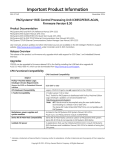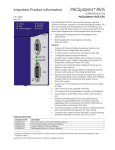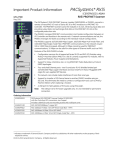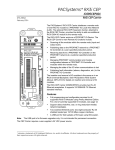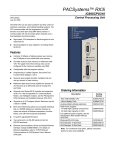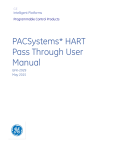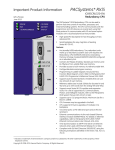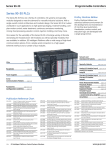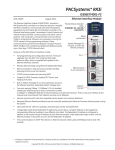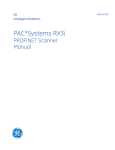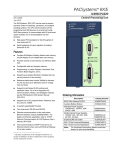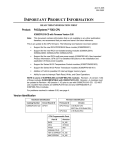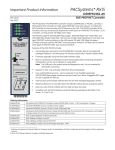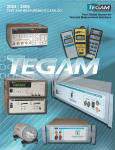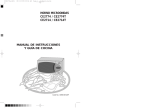Download PACSystems* RX3i CPU IC695CPE305 IPI
Transcript
Important Product Information
GFK-2714T
Novemberr 2015
PACSystems* RX3i CPU IC695CPE305-ADAS, Firmware Version 8.70
Overview
Firmware release 8.70 supports extended PROFINET device Subslot Numbers in order to support additional 3rd party
devices. The maximum Subslot Number for PROFINET devices has been increased from 255 to 21845.
This version also resolves the issues described in the section, Problems Resolved.
Field Upgrades
IC695CPE305 can be upgraded in the field to the most recent firmware (release 8.70) by installing the USB flash drive
upgrade kit 41G1733-MS10-000-A10. This kit can be downloaded from http://www.ge-ip.com/support.
New Features
Description
Feature
Extended PROFINET Subslot
Numbers
Firmware Release 8.70 supports extended PROFINET device Subslot Numbers. The
maximum Subslot Number for PROFINET devices has been increased from 255 to
21845.
Problems Resolved
Resolved Issue
Description
Unicast EGD Exchanges Stop
Producing After Loss of Device
Resolved issue where produced unicast EGD exchanges periodically stop producing
data when a destination unicast EGD consumer device is not present on the
network.
* Indicates a trademark of General Electric Company and/or its subsidiaries. All other trademarks are the property of their respective
owners.
Copyright © 2011-2015 by General Electric Company. All Rights Reserved.
PACSystems* RX3i CPU
2
GFK-2714T
IC695CPE305-ADAS
Functional Compatibility
Subject
Proficy* Machine Edition Logic
Developer Version Requirements
Description
PME 8.50 SIM 9 or 8.60 SIM 1 or later
Extended PROFINET device Subslot Number range – PME 8.60 SIM8 or later
Supports the HART® Pass Through
Feature
HART-capable RX3i Analog I/O modules can communicate HART data via this
CPU to compatible asset management tools. Refer to the PACSystems HART Pass
Through User Manual, GFK-2929 for more details.
The following RX3i analog modules support HART:
IC695ALG626
IC695ALG628 1
IC695ALG728
If used for HART Pass Through, the supporting RX3i PROFINET Controller (PNC001)
and PROFINET Scanner (PNS001 or CEP001) must also contain HART-compatible
firmware:
IC695PNC001 Firmware Release 2.20
IC695PNS001 Firmware Release 2.30
IC695CEP001 Firmware Release 2.30.
CPU Backward Compatibility
Legacy CPU310 Projects are not supported on the CPE305.
C Toolkit Compatibility
C Toolkit version 7.00 or later
The C Toolkit for PACSystems is distributed with Proficy® Machine Edition Logic
Developer. Updates can be downloaded from http://www.ge-ip.com/support.
Note: All C blocks must be recompiled using the new toolkit before
downloading to a release 7.00 or later CPU.
The Series 90 Toolkit (IC641SWP709/719) is not compatible with
PACSystems.
Backplanes, power supplies and
system modules
As listed in the PACSystems RX3i System Manual, GFK-2314.
Power Sync and Measurement module, IC694PSM001
Series 90-30 Main Rack
Compatibility
Series 90-30 Main Racks cannot be used in a PACSystems RX3i system.
Series 90-30 CPUs do not operate in PACSystems RX3i Racks.
Isolated 24Vdc power
In applications that use the IC69xALG220/221/222, consult PACSystems RX3i
System Manual, GFK-2314 for details on wiring the 24Vdc power.
COMMREQ to PBM300
In Release 3.0, the behavior of the COMMREQ fault output on a COMMREQ sent to
the PROFIBUS master module IC695PBM300 was changed to be compatible with
the Series 90-30 CPU366 PROFIBUS Master. Previously, the fault output was
enabled when the module received a COMMREQ and it was busy. Now, the busy
condition does not result in the fault output being enabled.
Recommended IC200ALG240
revision
When a VersaMax* system Genius* Network Interface Unit (IC200GBI001)
operates with a Genius Bus Controller located in an RX3i, and the VersaMax
system contains an IC200ALG240 Analog Input Module, it is recommended to
update the IC200ALG240 firmware to Revision 1.20 or later.
Upgrade kits are available at http://www.ge-ip.com/support.
Configuration of IC694MDL754
Always configure sixteen bits of module status when using this module.
Configuring zero bits of module status will result in invalid data in the module’s
ESCP status bits.
1
If used, IC695ALG628 must be installed in the RX3i CPU Rack. At time of publication, it is not supported by PROFINET scanners
IC695PNS001 or IC695CEP001. Refer to IPIs for IC695PNS001 or IC695CEP001 for future updates.
PACSystems* RX3i CPU
3
IC695CPE305-ADAS
GFK-2714T
Functional Compatibility
Subject
Description
PACSystems OPC UA servers support up to five concurrent sessions with up to
ten concurrent variable subscriptions and up to 12,500 variables. The
subscription limit is shared across all available sessions.
CIMPLICITY OPC UA Client
Ethernet Station Manager Modify
Command Support
PNC001 Version for Extended
PROFINET Subslot Numbers
When using CIMPLICITY OPC UA Client, ensure the total number of subscriptions
does not exceed the maximum. CIMPLICITY OPC UA Client is configured to create
one subscription for every 500 items by default. If, for example, a project
contains 1000 monitored items, CIMPLICITY creates two subscriptions. The
number of items per subscription may be modified from the Device Configuration
Panel / OPC UA DA Configuration / Subscriptions / Max. Number of Monitored
Items.
The CPE305/CPE310 Ethernet Station Manager supports monitor commands
only. Modify commands are not supported in firmware release 8.65 or later. Refer
to TCP/IP Ethernet Communications for PACSystems Station Manager Manual
GFK-2225M or later for additional information.
IC695PNC001 PROFINET Controller firmware version 2.25 or later is required to
configure PROFINET devices using extended subslot numbers.
Release History
Catalog Number
FW Version
Comments
IC695CPE305-ADAS
8.70
Firmware Release 8.70 supports extended PROFINET device Subslot Numbers. The
maximum Subslot Number for PROFINET devices has been increased from 255 to
21845.
IC695CPE305-ADAR
8.65
Firmware release 8.65 resolves security and OPC UA issues.
IC695CPE305-ADAP
8.50
Support for RX3i HART Pass Through.
IC695CPE305-ADAN
unchanged
IC695CPE305-ACAN
8.30
Adds support for EGD Class 1 on Embedded Ethernet Interface.
IC695CPE305-ACAM
8.20
Adds support for OPC UA.
IC695CPE305-ACAL
8.15
Replaces the module’s plastic housing with a metal case, improving noise immunity, reducing
emissions, and increasing the mechanical robustness of the product. No change to the
module’s firmware or functionality.
IC695CPE305-ABAL
8.15
Adds support for IC695RMX228 (128 MB Reflective Memory Module with Single Mode
Transceiver.)
Adds ability to read reflective memory status bits for IC695CMX128, IC695RMX128, and
IC695RMX228 (reflective memory modules).
Adds enhanced Ethernet diagnostics capabilities.
IC695CPE305-ABAK
8.05
Adds support for the new IC695ECM850 (IEC 61850 Ethernet Communication Module), which
operates as an IEC 61850 Client and provides connectivity to IEC 61850 Server devices.
Resolves three issues detailed in PACSystems RX3i CPU IC695CPE305-ABAK IPI, GFK-2714K.
IC695CPE305-ABAJ
7.80
Resolves the following issues:
• Unable to enter existing CPU password after Enhanced Security enabled.
• The PNC0001 fails to reconnect after remote IO power loss.
• The PBM300 stops responding after SUS_IO instruction executed.
Hardware revision –xDxx modifies the metal housing to provide easier access to the Real
Time Clock (RTC) battery from the rear of the module.
PACSystems* RX3i CPU
4
GFK-2714T
IC695CPE305-ADAS
Catalog Number
FW Version
Comments
IC695CPE305-ABAH
7.75
Corrects issues with the OEM lock functionality and with Ethernet communications. Adds
support for RX3i CMX/RMX modules version –CG (hardware version Cx with firmware version
2.00 and later).
For details, see PACSystems RX3i CPU IC695CPE305-ABAH IPI, GFK-2714H.
IC695CPE305-ABAG
7.70
Adds support for the following new modules: IC694MDL758, IC695CNM001 and IC694PSM001.
Refer to PACSystems RX3i CPU IC695CPE305-ABAG IPI, GFK-2714G for issues resolved.
IC695CPE305-ABAF
7.30
Adds support for Modbus/TCP Server, Modbus/TCP Client, SRTP Server, and SRTP Channels
from the embedded Ethernet port. For details, refer to PACSystems RX7i & RX3i TCP/IP
Ethernet Communications User Manual, GFK-2224L or later.
Release History
Catalog Number
FW Version
Comments
IC695CPE305-ABAE
7.16
Adds the ability to write DTR and read DSR, DCD, and RI on CPE310 Serial Port 1. This
functionality has been implemented (for all CPUs with RS-232 Serial ports) using COMMREQ
4304 (Write Port Control) & COMMREQ 4303 (Read Port Status).
IC695CPE305-ABAD
7.15
Adds native support for the new Power Sync and Measurement module (IC694PSM001) and
resolves several issues. Also introduces new features to augment security in the CPU
firmware and Proficy Machine Edition software. For details, see PACSystems RX3i CPU
IC695CPE305-ABAD IPI, GFK-2714D.
IC695CPE305-ABAC
7.14
Corrects an issue where executing a Run Mode Store, displaying the Proficy Machine Edition
Show Status window, or requesting data using the PACSAnalyzer tool could cause discrete
output modules to unexpectedly change state momentarily (up to one PLC scan).
Corrects an issue that was introduced in release 7.13, which prevented configuration of
Modbus TCP on Ethernet modules.
IC695CPE305-ABAC
7.13
Corrects issues with Logic Write to Flash (Service Request 57).
IC695CPE305-ABAB
7.11
Resolves the issues detailed in PACSystems RX3i CPU IC695CPE305-ABAB IPI, GFK-2714A.
IC695CPE305-AAAA
7.10
Initial release.
Restrictions and Open Issues
Note: Ethernet functionality described below only applies to Rx3i CPUs that provide an embedded Ethernet interface.
Additionally, because the CPE310 does not utilize a battery, items related to battery backed memory and/or the
battery itself have been removed from this section.
Restrictions and Open Issues
Restriction/Open Issue
Description
Serial I/O Half Duplex Mode
Failures at Low Baud Rates
When the CPE305 or CPE310 serial port is configured for Serial I/O protocol with
2-wire half-duplex serial port mode with baud rates less than 19.2kBaud, the last
transmitted character may end up as the first character in the receive message
buffer upon switching from transmitting to receiving.
Rare Power-Up Problem on
CPE305 and CPE310
When the CPE305 or CPE310 has logic and configuration source set to flash, in
rare instances the controller will power up with all LEDs blinking in unison and
the controller will be unreachable. An additional power down and then power up
cycle will allow the controller to completely power up.
Missing Addition of IOC event
when ECM850 module restarts
due to reset pushbutton or
SVC_REQ 24
When ECM850 module RESET is triggered using SVC_REQ 24 or Reset
pushbutton, CPU does not report Addition of IOC fault message in Controller fault
table after successful reset of module.
PACSystems* RX3i CPU
5
IC695CPE305-ADAS
GFK-2714T
Restrictions and Open Issues
Restriction/Open Issue
Description
Flash part issue on
CPE305/CPE310 modules shipped
in 2012
When the CPE305 or CPE310 powers down with an Energy Pack connected, all
user memory is written out to the NVS flash device. In 2012, GE Intelligent
Platforms received a batch of flash memory chips that exhibited longer write
times, which exceeded the capabilities of the Energy Pack. This will resulted in
the CPE310 not retaining memory during a power-cycle event and logging a User
memory not preserved fault.
The parts that exhibit the extended write times went obsolete in 2012. Units
shipped after January 1st, 2013 or prior to 2012 do not have the substandard
part.
Units shipped in 2012 that exhibit the symptoms of the issue (User memory not
preserved fault after power cycle with a working Energy Pack) can be replaced
via the warranty return policy.
Ethernet COMMREQs not always
delivered on the first logic sweep
In certain instances where User Logic is of sufficient size and a COMMREQ is
issued on first logic sweep, the COMMREQ may be aborted before its
transmission is attempted. The condition is much more observable on
COMMREQs issued from the CPU’s embedded Ethernet port. To avoid the
possibility of encountering this condition, users should avoid issuing COMMREQs
on first logic sweep.
PMM335 loss is occasionally
detected on power down of the
CPU. (Module is not lost on powerup.)
The PMM335 PACMotion Multi-axis Motion Controller monitors power loss,
independently of the CPU. The CPU is fast enough that it can occasionally detect
and log the loss of the PMM335 just before the CPU itself powers down.
No corrective action is required. This situation can be verified in two ways:
(1) by inspecting the timestamp in the Loss of Module report one can correlate it
with the power-down event, and
(2) by performing a PME Show Status Details report to see that the PMM335 is
present after power-up.
Ethernet rack-based module fails
to exchange EGD data properly
during power cycling
Very rarely, after experiencing multiple rapid power cycles, the CPU may fail to
establish communication with one or more modules in the backplane at power
up. When this occurs, several pairs of Loss of, or missing option module and Reset
of option module faults with identical timestamps will be logged in the controller
fault table. If the module is an Ethernet module, an event 30H is recorded in its
station manager event log.
To recover from this issue, cycle power again.
Loss of Power Supplies after
firmware update
A Loss of Power Supplies after firmware update may occur. This does not happen
with all firmware updates and will not occur if the system is power cycled after
the firmware upgrade has completed. The faults displayed when this issue
occurs are as follows:
0.0 Loss of, or missing option module 01-12-2009 11:25:38
Error Code Group Action Task Num
36 4 3:Fatal 9
Fault Extra Data:
01 58 02 4f 80 08 0a 07 00 00 00 00 00 00 00 00 00 00 00 00 00 00 00 00
Hot swapping some analog
modules slowly result in modules
not being recognized
Occasionally during a hot insertion (hot swap) of IC695 Non-Isolated Analog
Input Modules, input channels may take up to 2 seconds to reflect actual input
values after the Module OK bit is enabled in the module status word. This has
only been seen when the hot insertion has been done slowly (i.e. approximately
1.5 seconds to insert the module)
PACSystems* RX3i CPU
6
GFK-2714T
IC695CPE305-ADAS
Restrictions and Open Issues
Restriction/Open Issue
Description
Simultaneous clears, loads and
stores not supported
Currently, PACSystems CPUs do not support multiple programmers changing
CPU contents at the same time. The programming software may generate an
error during the operation. Simultaneous loads from a single controller are
allowed.
Hardware configuration Not Equal
after changing target name
If the user stores a hardware configuration to flash that sets Logic/Config Power
up Source to Always Flash or Conditional Flash and then subsequently changes
the name of the target in the programming software, the hardware
configuration will go Not Equal and will not Verify as equal.
Controller and IO Fault Tables
may need to be cleared twice to
clear faulted state
Both Controller and IO fault tables may need to be cleared to take the CPU out of
Stop/Fault mode. If one of the tables contains a recurring fault, the order in
which the tables are cleared may be significant. If the CPU is still in Stop/Fault
mode after both tables are cleared, try clearing the fault tables again.
Setting force on/off by storing
initial value
Once a force on or force off has been stored to the RX3i, you cannot switch from
force on to force off or vice-versa directly by downloading initial values. To turn
off the force, perform a download, and then change the force on or off by
another download.
Number of active programs
returned as zero
The SNP request Return Controller Type and ID currently returns the number of
active programs as zero.
Serial I/O failure at 115K during
heavy interrupt load
Rare data corruption errors have been seen on serial communications when
running at 115K under heavy interrupt load on the RX3i. Under heavy load
applications, users should restrict serial communications to 57K or lower.
SNP ID not always provided
Unlike the Series 90-30, the RX3i CPU’s SNP ID will not appear in the Machine
Edition programmer Show Status display. Service Request 11 will always return
zeroes.
Second programmer can change
logic while in Test & Edit mode
While currently active in a Test and Edit session using Machine Edition on one PC,
Machine Edition running on another PC is not prevented from storing new logic
to the RX3i.
Must have logic if powering-up
from flash
If the application will configure the CPU to retrieve the contents of flash memory
at power-up, be sure to include logic along with hardware configuration when
saving to flash memory.
Two Loss of Module faults for
Universal Analog Module
Occasionally, the hot removal of the Universal Analog Input Module
(IC695ALG600) results in two Loss of I/O Module faults instead of one.
Power up of Series 90-30 HSC
module may take as long as 20
seconds
As power is applied to a 90-30 High-Speed Counter, the module ready bit in the
status bits returned each sweep from the module may not be set for as long as
20 seconds after the first PLC sweep, even though there is no loss of module
indication. I/O data exchanged with the module is not meaningful until this bit is
set by the module. Refer to PACSystems RX3i and Series 90-30 High Speed
Counter Modules User’s Manual, GFK-0293, Chapter 4.
Informational fault at power-up
Intermittently during power-up, an Informational non-critical CPU software fault
may be generated with fault extra data of 01 91 01 D6. This fault will have no
effect on the normal operation of the RX3i. But, if the hardware watchdog timer
expires after this fault and before power has been cycled again, then the outputs
of I/O modules may hold their last state, rather than defaulting to zero.
Extended memory types for IO
triggers
%R, %W and %M cannot be used as IO triggers.
SNP Update Datagram message
If an Update Datagram message requests six (or fewer) bits (or bytes) of data, the
RX3i will return a Completion Ack without Text Buffer. The protocol specifies that
the returned data will be in the Completion Ack message, but it may not be
present.
PACSystems* RX3i CPU
7
IC695CPE305-ADAS
GFK-2714T
Restrictions and Open Issues
Restriction/Open Issue
Description
GBC30 may not resume operation
after power cycle
In rare instances, a GBC30 in an expansion rack may not resume normal
operation after a power cycle of either the expansion rack or the main rack.
Configuration of third-party
modules
Do not specify a length of 0 in the configuration of a third-party module. The
module will not work properly in the system.
Power supply status after CPU
firmware update
The RX3i will report a Loss of or missing option module fault for the IC695PSD140
power supply following an update of CPU firmware. Also, the slot will appear
empty in the programmer’s online status detail view. The power supply continues
to operate normally. Power cycle to restore normal status reporting.
Power supply status after power
cycling
Rarely, turning a power supply on or off may not result in an add or loss fault.
Also, the slot will appear empty in the programmer’s online status detail view.
The power supply continues to operate normally. To restore normal status
reporting, cycle the power.
Don’t use multiple targets
In a system in which the hardware configuration is stored from one target and
logic is stored from a different target, powering-up from flash will not work. The
observed behavior is that, following a power up from flash, PME reports
hardware configuration and logic not equal.
Missing Loss of terminal block
fault
The IC695ALG600/608/616 analog input modules do not produce a Loss of
Terminal Block fault when hardware configuration is stored or the module is
hot-inserted, and the terminal block is not locked into place.
Sequence Store Failure
When downloading projects with very large hardware configuration or which use
large amounts of user memory, it is possible to encounter a PLC Sequence Store
Failure error when writing the project to flash. To avoid this error, either or both
of the following actions may be helpful:
1. Perform an explicit clear of flash prior to performing the write.
2. Increase the operation timeout used by ME prior to performing the write. This
is done by expanding the Additional Configuration in the Inspector window
for the target controller, and adjusting Request Timeout. The timeout may
need to be increased to as much as 60000 msec, depending on the amount
of memory used and the condition of the flash memory.
IC694MDL754: must configure
module status bits
Always configure sixteen bits of module status when using this module.
Configuring zero bits of module status will result in invalid data in the module’s
ESCP status bits.
IC695ALG600 Lead Resistance
Compensation setting
A configuration store operation will fail if a channel is configured for 3-wire RTD
and Lead Resistance Compensation is set to Disabled. A Loss of Module fault will
be logged in the I/O Fault table at the end of the store operation. To recover the
lost module, the configuration must be changed to enable Lead Resistance
Compensation and module must be power cycled.
WinLoader may stop operating
On computers running Windows 2000 and using some versions of Symantec
Antivirus protection, WinLoader will lock up if used in Advanced mode. To
recover, cycle the computer's power.
Logic and HWC not equal after
power cycle
If the Hardware Config from Target 1, with Logic/Configuration Power-up Source
and Data Source both set to Always from Flash, is stored in Flash, and then Logic
and Hardware Config from Target 2, with Logic/Configuration Power-up Source
both set to Always from RAM, are stored to RAM and there is a good Energy Pack,
when power is cycled the programmer may show that Logic and Hardware
Config are not equal. The remedy is to clear Flash and re-store the Logic and
Hardware Config from Target 2.
PACSystems* RX3i CPU
8
GFK-2714T
IC695CPE305-ADAS
Restrictions and Open Issues
Restriction/Open Issue
Description
WinLoader does not detect PC
COM port in use when upgrading
PACSystems CPU
WinLoader does not detect whether a PC's COM port is in use when attempting
to connect to a PACSystems CPU to perform a firmware upgrade. If the port is
already in use it displays the status trying to connect followed by waiting for
target. To proceed with the upgrade, press the abort button and disconnect the
other application that is using the COM port.
WinLoader does not display error
when it cannot connect serially
with PACSystems CPU
WinLoader does not display an error message if it cannot connect to a
PACSystems CPU to perform a firmware upgrade. This occurs if the cable is
physically not connected to the CPU or if the CPU's serial port is not configured
for the same baud as WinLoader. In this case Winloader displays the status
trying to connect followed by waiting for target. To proceed with the upgrade,
press the abort button and correct the cable or baud rate setting.
SRTP connections remain open
after IP address changed
The Ethernet Interface does not terminate all open SRTP connections before
changing its IP address. Thus, once the local IP address has changed, the
privileged connection may not be available until the TCP keep-alive timeout has
expired.
If quicker recovery of the SRTP connection is needed, modify the wkal_idle
Advanced User Parameter to reduce the TCP keep alive timer down to the
desired maximum time for holding open the broken connection. Refer to
PACSystems RX7i & RX3i TCP/IP Ethernet Communications User Manual,
GFK-2224, for details.
REPP does not save results of
aborted PING
The station manager REPP command does not retain the results of a PING that is
aborted due to error. The PING results are reported when the PING is aborted,
but subsequent REPP commands give the results of the last successfully
terminated PING.
Multiple log events
The Ethernet Interface sometimes generates multiple exception log events and
Controller Fault Table entries when a single error condition occurs. Under
repetitive error conditions, the exception log and/or Controller Fault Table can be
completely filled with repetitive error messages.
Clear of large hardware
configurations may cause log
event 08/20
A Log event 08/20 may occur when very large hardware configurations are
cleared and transfers are active on other Server connections. This log event can
be safely ignored.
PLC response timeout errors (8/08)
in Ethernet exception log under
extremely heavy SRTP traffic
Under extremely heavy SRTP traffic conditions, the Ethernet Interface may log an
event in the Ethernet exception log (Event 8, Entry 2 = 08H) indicating an
overload condition. This error terminates the SRTP connection. If this event
appears, either the traffic load should be reduced, or the application should use
an alternate communications method to verify that critical data transfers were
not lost due to the overload.
SRTP channel transfers may take
up to 20 seconds after power cycle
When SRTP communications are interrupted by a power cycle, the Ethernet
interface may require up to 20 seconds to re-establish TCP connection used for
SRTP communications.
TCP connection may timeout early
if the timeout is set above 10
minutes
If the TCP connection timeout is set higher than 10 minutes, the connection may
time out before the configured value. The connection timeout is derived from
three AUP parameters:
wkal_idle + (wkal_cnt + 1) * wkal_intvl
Although the parm v Station Manager command works correctly, the v
subsystem code (SRTP server) is not shown as supported by the online help.
Station Manager PARM command
help text is wrong
PACSystems* RX3i CPU
9
IC695CPE305-ADAS
GFK-2714T
Restrictions and Open Issues
Restriction/Open Issue
Description
Blink code upon power-up
In rare occasions a blink code of 9-1-1-15 may be reported upon power up.
To resume operation the unit must be power cycled again with the Energy Pack
disconnected.
All CPE LEDs blinking in unison at
power-up
In very rare occasions a CPE305 may power up erroneously indicating an over
temperature condition (all CPU status lights blinking on and off in unison) and fail
to go into run mode.
To resume operation the unit must be power cycled again (with or without the
Energy Pack connected.)
Watchdog Timer Trip on LogicInitiated Read or Write of User
Nonvolatile RAM
In rare instances, a Logic Driven Read or Write of User Nonvolatile RAM via
Service Request 56 or Service Request 57 on a CPE310 can result in the
expiration of the Software Watchdog Timer. The expiration of the Software
Watchdog forces the CPE into a Stop Halt state.
If this occurs the user must remove the Energy Pack and cycle power to the CPU
to clear the failure mode. To resume operation the unit must then have project
downloaded again from the programmer or via RDSD.
PACSystems* RX3i CPU
10
GFK-2714T
IC695CPE305-ADAS
Operational Notes
Note: Ethernet functionality described below only applies to Rx3i CPUs that provide an embedded Ethernet interface.
Additionally, because the CPE310 does not utilize a battery, items related to battery backed memory and/or the
battery itself have been removed from this section.
Note: For a summary of operational differences between Series 90 and PACSystems RX3i controllers, refer to
Series 90 to PACSystems Applications Conversion Guide, GFK-2722.
Operational Note
Description
Firmware upgrades using
Slot 1
Firmware upgrades for modules in Slot 1 will only work for CPUs. Modules other than the CPU
need to be in Slot 2 or higher to perform a firmware upgrade.
Some PROFINET
configurations may be too
large for IC695CPE305
memory
While the CPE305 is capable of utilizing hardware configurations with the maximum allowed
PROFINET IO Device count of 255 PROFINET IO Devices, hardware configurations approaching the
maximum allowed IO Submodule count of 2048 IO Submodules may nearly exhaust the available
5 MB of User Memory. Customers requiring hardware configurations approaching the maximum
allowed IO Submodule count of 2048 IO Submodules should consider using a CPU model with
more available User Memory, such as the CPE310, CPU315, or CPU320
Serial port operation
C Toolkit Application
Compatibility
Beginning with Rel 7.00 of the C Toolkit, writes to %S memory will fail to compile. In previous
releases a compilation warning was issued. This affects use of the GE supplied C Toolkit macros
Sw(), Si(), and Sd().
Multiple calls to SVC_REQ 57
(Logic Driven Write to
Nonvolatile Storage) in a
single sweep)
Multiple calls to SVC_REQ 57 could cause the CPU to trip the watchdog timer and go to STOPHALT mode. The number of calls to SVC_REQ 57 that can be made depends on variables such as
the software watchdog timeout value, how much data is being written, how long the sweep is,
age of nonvolatile storage (flash), etc.
GE Intelligent Platforms recommends limiting the number of calls to SVC_REQ 57 to one call per
sweep to avoid the potential of going to STOP-HALT mode.
The Logic Driven Read/Write to Flash service requests are not intended for high frequency use.
Depending on the amount of data being accessed and the condition of the flash memory, writing
to flash could take more than one sweep interval to finish. If the application attempts to write to
flash too frequently, the CPU could experience a watchdog timeout while waiting for a preceding
write operation to complete. To avoid the potential for causing a watchdog timeout (resulting in
the CPU going to Stop-Halt), the application should be designed such that one Logic Driven Write
operation (SVC_REQ 57) is executed per sweep.
For firmware version 6.70 and later, the RUN LED for remote/expansion racks will reflect the
current IO enable/disable state (even when there are no output modules in the expansion rack).
RUN LED for remote/expansion rack with input modules only works as follows for all versions
prior to version 6.70:
When a remote or expansion baseplate is used with the RX3i, the RUN LED on the Series 90-30
power supply for that baseplate is illuminated when the system is in Run mode only if the rack
contains at least one output module. If the rack contains input modules only, the RUN LED is not
illuminated. This is due to the way input modules are managed in the PACSystems design and
does not indicate an error.
In Release 5.00 or later, if an attempt is made to download a C block containing undefined
symbols, the download will fail. Machine Edition will display the following message in the
Feedback Zone: Error 8097: Controller Error – Controller aborted the request [0x05][0xFF]
Prior to Release 5.00, C blocks containing undefined symbols could be successfully downloaded,
but if they were executed the CPU would transition to Stop/Halt mode.
Use of SVC_REQ 56 and 57
should be limited in
frequency to avoid CPU
watchdog timeouts
RUN LED is not illuminated
on the Series 90-30 power
supply for an RX3i
remote/expansion rack with
input modules only
Undefined Symbols in
C Blocks
Cable IC693CBL316 must be used for RS-232 serial connections to the CPE305.
The RS-232 port does not supply the 5V power offered by earlier RX3i and Series 90-30 CPUs.
PACSystems* RX3i CPU
11
IC695CPE305-ADAS
GFK-2714T
Operational Note
Slot numbering, power
supply placement, CPU
placement and reference
Description
1.
2.
3.
The A/C Power-Supply (IC695PSA040) for the RX3i is a doublewide module whose connector
is left justified as viewed when installed in a rack. It cannot be located in Slot 11 of a 12-slot
rack nor Slot 15 of a 16-slot rack. No latch mechanism is provided for the last (right-most)
slot in a rack, therefore it is not possible to place the power-supply in the second to last slot.
When migrating a Series 90-30 CPU system to a PACSystems RX3i CPU, be aware that to
maintain the Slot 1 location of the CPU, only a singlewide power-supply may be used in Slot
0. Either DC power supply can be used (IC695PSD040 or IC695PSD140). Therefore, if the
application using an existing Series 90-30 system must maintain a Slot 1 CPU and uses an
AC power-supply, the RX3i system must have the RX3i AC power-supply located in a slot to
the right of the RX3i CPU in Slot 1.
In deciding to place the CPU in slots other than Slot 1, the user should be aware of the
possible application migration issues that could arise. The following lists the areas that
could be affected when migrating an application from one CPU slot to another.
Item Affected
User Logic
Service Request #15
(Read Last-Logged Fault
Table Entry)
Service Request #20
(Read Fault Tables)
How Affected
Location of CPU faults will not be the standard
0.1 location, but will reflect the slot the CPU is
located in. User logic that decodes fault table
entries retrieved by these service requests may
need updating.
Communications
Request (COMMREQ)
COMMREQs directed to the CPU (e.g. those
directed to the serial ports of the CPU) will need
to be updated with the correct CPU slot
reference.
H/W
Configuration
CPU Slot location
Slot location of the CPU must be updated in the
HW Configuration to reflect the CPU’s true
location.
Fault Tables
Faults logged for the
CPU
External
Devices
The location of faults logged for the CPU in the
fault table will not be the standard 0.1 (rack.slot)
location, but will reflect the CPU’s actual slot.
Note: CPE releases prior to 7.30 can communicate only with a programmer.
Additional protocols and communication with other devices are not
supported.
Series 90 PLCs
Remote Series 90 PLCs that use SRTP Channels COMMREQs expect the CPU
to be in slot 1. In order to support communications with Series 90 SRTP
clients such as Series 90 PLCs using SRTP Channels, the RX3i internally
redirects incoming SRTP requests destined for {rack 0, slot 1} to {rack 0, slot
2}, provided that the CPU is located in rack 0 slot 2 (and the remote client
has not issued an SRTP Destination service on the connection to discover
the rack and slot of the CPU). This special redirection permits Series 90-30
applications that expect the power supply to be located leftmost and the
CPU to be located to the right of the power supply to function. Attempts to
establish channels with CPUs in slots other than 1 or 2 will fail if initiated
from Series 90 PLCs.
HMI and External Communication Devices
All external communication devices that interact with the CPU should be
checked for compatibility with CPU slot locations other than slot 1. Problems
may arise with, but are not limited to, initial connection sequences and fault
reporting. Machine Edition View customers should select GE SRTP as their
communications driver – it can communicate with a CPU in any slot.
Host Communications Toolkit (HCT)
Applications that utilize the Host Communications Toolkit may require
updated drivers.
PACSystems* RX3i CPU
12
GFK-2714T
IC695CPE305-ADAS
Operational Note
Length of serial I/O buffer
LD-PLC operations
Description
Effective with Release 5.70, the Set Up Input Buffer Function will always allocate a buffer
containing 2097 bytes. This is one byte more than previous PACSystems releases.
Machine Edition LD-PLC no longer supports a function that connects to the PLC, downloads, and
then disconnects from the PLC. The connect and download functions are now separate. To
perform a download to the PLC, you must first connect to the PLC.
Duplicate station address for
Modbus will conflict with
other nodes
The default serial protocol for the RX3i is Modbus RTU. The default Station Address is 1. If the PLC
is added to a multi-drop network, care must be taken that the PLC is configured with a unique
Station Address. Nodes with duplicate Station Addresses on the same network will not work
correctly.
Timer operation
Care should be taken when timers (ONDTR, TMR, and OFDTR) are used in program blocks that are
NOT called every sweep. The timers accumulate time across calls to the sub-block unless they
are reset. This means that they function like timers operating in a program with a much slower
sweep than the timers in the main program block. For program blocks that are inactive for large
periods of time, the timers should be programmed in such a manner as to account for this catch
up feature.
Related to this are timers that are skipped because of the use of the JUMP instruction. Timers that
are skipped will NOT catch up and will therefore not accumulate time in the same manner as if
they were executed every sweep.
Constant sweep
Constant Sweep time, when used, should be set at least 10 ms greater than the normal sweep
time to avoid any over-sweep conditions when monitoring or performing on-line changes with
the programmer. Window completion faults will occur if the constant sweep setting is not high
enough.
Large number of COMMREQs
sent to module in one sweep
causes faults
A large number of COMMREQs (typically greater than 8) sent to a given module in the same
sweep may cause Module Software faults to be logged in the Controller fault table. The fault
group is MOD_OTHR_SOFTWR (16t, 10h) and the error code is COMMREQ_MB_FULL_START (2).
When this occurs, the FT output of the function block will also be set. To prevent this situation,
COMMREQs issued to a given module should be spread across multiple sweeps so that only a
limited number (typically 8 or less) of COMMREQs are sent to a given module in each sweep. In
addition, the FT output parameter should be checked for errors. If the FT output is set (meaning
an error has been detected), the COMMREQ could be re-issued by the application logic.
C Block standard math
functions do not set errno
In C Blocks, standard math functions (e.g. sqrt, pow, asin, acos) do not set errno to the correct
value and do not return the correct value if an invalid input is provided.
Upgrading firmware
Upgrading the CPU firmware with the WinLoader utility may fail when multiple IO modules
are in the main rack, due to the time it takes to power cycle the rack system. If the upgrade
process fails, move the CPU to a rack without IO modules and restart the upgrade process.
Winloader initial connect baud rate is fixed at 19200 baud. Note that the firmware download
will occur at 115.2K baud by default.
Note that if you have hyperterm open on a port, and then try to use Winloader on the same
port, Winloader will often say Waiting for Target until the hyperterm session is closed.
Hot swap
Hot swap of CPUs is not supported.
Serial port configuration
COMMREQs
With the following combination of circumstances, it is possible to render serial communications
with the CPU impossible:
User configuration disables the Run/Stop switch
User configures the power up mode to Run or Last
Logic is stored in FLASH and user configures CPU to load from FLASH on power-up
User application issues COMMREQs that set the protocol on both of the serial ports to
something that does not permit communications to the PME programmer.
Run Mode Store of EGD
Rx3i rack-based Ethernet modules (IC695ETM001) must be running firmware version 6.00 or
greater to utilize the Run Mode Store of EGD feature.
LAN must be tree, not ring
The hub or switch connections in an Ethernet network must form a tree and not a ring; otherwise
duplication of packets and network overload may result. In this situation, the RX3i Ethernet
modules will continually reset.
Reporting of duplicate IP
address
The PACSystems RX3i does not log an exception or a fault in the Controller Fault Table when it
detects a duplicate IP address on the network.
PACSystems* RX3i CPU
13
IC695CPE305-ADAS
Operational Note
GFK-2714T
Description
SRTP connections remain
open after IP address
changed
The Ethernet Interface does not terminate all open SRTP connections before changing its IP
address. Once the local IP address has changed, any existing open TCP connections are unable to
normally terminate. This can leave SRTP connections open until their underlying TCP connections
time out. If quicker recovery of the SRTP connection is needed, modify the wkal_idle Advanced
User Parameter to reduce the TCP keep alive timer down to the desired maximum time for
holding open the broken connection. Refer to PACSystems RX7i & RX3i TCP/IP Ethernet
Communications User Manual, GFK-2224, for details.
Lengthy CPE backplane
operations
Some exceptionally lengthy CPE backplane operations, such as MC_CamTableSelect, Data Log,
and Read Event Queue functions, will take longer to complete compared to other RX3i CPU
models, and may delay backplane operations to IC695 modules.
For example, when an MC_CamTableSelect function block is executed on the PMM335 module,
the CPU’s acknowledgement of the PMM355 module interrupt may be delayed. In this situation,
you may see the following fault in the I/O Fault Table, even when the interrupt has not been
dropped: Error initiating an interrupt to the CPU.
Incorrect COMMREQ status
for invalid program name
The program name for PACSystems is always LDPROG1. When another program name is used in
a COMMREQ accessing %L memory, an Invalid Block Name (05D5) error is generated.
FANUC I/O Master and Slave
operation
Scan sets on the master do not work properly for the first operation of the scan set after entering
RUN mode. They do work properly for subsequent scans.
After downloading a new hardware configuration and logic, a power cycle may be required to
resume FANUC I/O operation.
Use PLCs of similar performance in FANUC I/O networks. If a master or slave is located in an RX3i
system, the other PLCs should be RX3i CPUs or Series 90-30 CPU374s.
Repeated power up/down cycles of an expansion rack containing FANUC I/O slaves may result in
failure of the slaves’ operation, with the RDY LED off.
Lost count at power-up for
Serial IO Processor
The serial IO Processor (IC693APU305) will lose the first count after every power up or every time
the module receives a configuration.
COMMREQ status words
declared in bit memory types
must be byte-aligned
In releases prior to 3.50, the CPU allowed configuration of COMMREQ Status Words in bit memory
types on a non-byte-aligned boundary. Even though the given reference was not byte-aligned,
the firmware would adjust it the next-lowest byte boundary before updating status bits,
overwriting the bits between the alignment boundary and specified location. To ensure that the
application operates as expected, release 3.50 requires configuration of COMMREQ Status Words
in bit memory types to be byte-aligned. For example if the user specified status bit location of
%I3, the CPU aligns the status bit location at %I1. Release 3.50 firmware requires the user to
specify the appropriate aligned address (%I1) to ensure that the utilized location is appropriate
for their application. Note that the actual reference location utilized is not changed, but now is
explicitly stated for the user.
STOP and RUN mode
transition priority
The PACSystems CPU receives requests to change between stop and run mode from many
different sources. These include (but are not limited to) Proficy Machine Edition, HMIs, the user
application, and the RUN/STOP switch. Since there are many potential sources for a mode
change request, it is possible to receive a new mode change request while another is already in
progress. When this occurs, the CPU evaluates the priority of the new mode change request with
the mode change that is in progress. If the new mode change request has an equal or higher
priority than the one already in progress, the CPU transitions to the new mode instead of the one
in progress. If, however, the new mode change request has a lower priority than the one in
progress, the new mode request is discarded and the CPU completes the mode change that is in
progress. The sweep mode priorities are (listed from highest to lowest priority) STOP HALT, STOP
FAULT, STOP, and RUN.
Note: The IO ENABLED/DISABLED state is not part of the mode priority evaluation.
For example, a CPU is in RUN IO ENABLED mode and a SVC_REQ 13 function block is executed to
place the CPU into STOP IO DISABLED mode. Before the transition to STOP IO DISABLED is
completed, the RUN/STOP switch is changed from RUN IO ENABLED to RUN IO DISABLED. In this
case, the CPU ignores the new request from the RUN/STOP switch to go to RUN IO DISABLED
mode because it is already processing a request to go to STOP IO DISABLED mode and STOP
mode has a higher priority than RUN mode.
PACSystems* RX3i CPU
14
GFK-2714T
IC695CPE305-ADAS
Operational Note
Description
Nuisance faults sometimes
logged for missing power
supply
If a power supply is missing or has some fault that makes it appear to be missing, the CPU may
improperly report (upon download of configuration) more than one fault. Such additional faults
may be safely ignored and will not occur in a properly configured rack (with no mismatches or
missing modules),
Uploaded controller
supplemental files lose date
and time
Controller supplemental files uploaded from the CPU are time stamped as 8/1/1980 12:08AM
regardless of PC or PLC time.
OPC UA Sessions,
Subscriptions, & Variables
PACSystems OPC UA servers support up to five concurrent sessions with up to ten concurrent
variable subscriptions and up to 12,500 variables. The subscription limit is shared across all
available sessions.
Embedded Ethernet Interface
Embedded Ethernet Interface Restrictions and Open Issues
Restriction/Open Issue
Description
Ethernet disconnect during
word-for-word change
If the Ethernet connection is broken during a word–for-word change, the programmer may not
allow a subsequent word-for-word change after reconnecting due to the fact that it thinks
another programmer is currently attached. If this occurs, you should go offline and then back
online again.
Possible PME inability to
connect
Infrequently, an attempt to connect a programmer to an RX3i via Ethernet will be unsuccessful.
The normal connection retry dialog will not be displayed. Rebooting the computer that is running
the programmer will resolve the behavior.
Spurious Ethernet fault
In rare instances, after power cycle, the Ethernet Interface may log the following fault, Event =
28h, Entry 2 = 000Eh. This fault can be safely ignored.
Intermittent Ethernet log
event 8H/15H after power
cycle
When starting after a power cycle, the Ethernet Interface may intermittently log an exception
(entry 8H, Entry 2 = 15H, Entry 3 = 0000H, Entry 4 = 00aaH). This exception is benign and may be
ignored.
Station Manager PING
commands
When initiating ICMP echo requests from the PLC via Station Manager’s PING command, the
operation occasionally fails and an exception is logged (Event eH, Entry 2 = 6H).
Embedded Ethernet Interface Operational Notes
Embedded Ethernet Interface Operational Notes
Operational Note
Description
Configuration of IP address
is required before using
Ethernet communications
Note:
BOOTP and the SetIP tool in PME are not supported.
The embedded Ethernet Interface cannot operate on a network until a valid IP address is
configured. (The default IP address is 192.168.0.100.) The Ethernet addressing information must
be configured prior to actual network operation, or to recover from inadvertent changes to the
Ethernet addressing data at the Ethernet Interface. Use one of the following methods to initially
assign an IP address:
Download a CPE configuration from the Programmer using a serial connection.
Download a CPE configuration from the Programmer using the Ethernet connection of an
ETM001 in the same rack with a known IP address configuration.
Programmer version
requirements
Proficy Machine Edition Logic Developer PLC 7.00 SIM3 or later must be used to configure the
embedded Ethernet port of a CPE305.
Ethernet Event Log not
preserved across power
cycle
The Ethernet event log on the CPE305 is not maintained across a power-cycle. However, Ethernet
log events will be reported in the Controller Fault Table as with other Rx3i CPUs. An Energy Pack
can be used to preserve these entries when power is lost.
Station Manager commands
A subset of the documented Station Manager Commands will be supported for the CPE305. Refer
to TCP/IP Ethernet Communications for PACSystems Station Manager Manual, GFK-2225J or later
for details.
PACSystems* RX3i CPU
15
IC695CPE305-ADAS
GFK-2714T
Embedded Ethernet Interface Operational Notes
Operational Note
AUP parameter restrictions
Description
The Advanced User Parameter wsnd_buf should not be changed by the user. Changing the
value of this parameter may cause the Ethernet Interface to drop its connection and the LAN
LED to turn off.
When explicitly configuring speed or duplex mode for a PACSystems RX3i port using
Advanced User Parameters (AUP), do not request a store to flash as a part of the download
when communicating over the CPE's embedded Ethernet port. In this situation you first must
store to the RX3i and then initiate a separate request to write to flash.
Changing IP address of
Ethernet interface while
connected
Storing a hardware configuration with a new IP address to the RX3i while connected via Ethernet
will succeed, then immediately disconnect because the RX3i is now using a different IP address
than the Programmer. You must enter a new IP address in the Target Properties in the Machine
Edition Inspector window before reconnecting.
Proper IP addressing is
always essential
The PACSystems Ethernet Interface must be configured with the correct IP Address for proper
operation in a TCP/IP Ethernet network. Use of incorrect IP addresses can disrupt network
operation for the PACSystems and other nodes on the network. Refer to PACSystems RX7i & RX3i
TCP/IP Ethernet Communications User Manual, GFK-2224 for important information on
IP addressing. When storing a new HW configuration to the RX3i, be sure that the HW
configuration contains the proper Ethernet addressing data (IP Address, Subnet Mask, and
Gateway IP Address) for the RX3i.
Note:
Machine Edition programming software maintains the target IP address (used to
connect the programmer to the target) independent of the contents of the HW
Configuration for that target). The target IP address is set in the Target Properties in the
Machine Edition Inspector window. Storing a HW Configuration whose Ethernet
addressing data contains an IP Address that is different from the RX3i target IP address
will change the IP address used by the target RX3i as soon as the Store operation is
completed; this will break the Programmer connection. Before attempting to reconnect
the Programmer, you must change the target IP address in the Target Properties in the
Machine Edition Inspector window to use the new IP address. To regain communication
at the former IP address, use the manual corrective action described above.
Storing a HW Configuration containing incorrect Ethernet addressing data to the PACSystems
RX3i will result in loss of the Programmer connection and will require manual corrective action as
described above.
PACSystems* RX3i CPU
16
GFK-2714T
IC695CPE305-ADAS
Embedded Ethernet Interface Operational Notes
Operational Note
Description
10Base-T / 100Base-TX autonegotiating full-duplex
Ethernet ports
The PACSystems RX3i CPU with embedded Ethernet provides a direct connection to one 10Base-T
/100Base-TX CAT5 (twisted pair) Ethernet LAN cable from one network port. By comparison, Rx3i
peripheral Ethernet modules (IC695ETM001) provide direct connection to one or two 10Base-T
/100Base-TX CAT5 (twisted pair) Ethernet LAN cables from two network ports. In either case, the
Ethernet-enabled device has only one IP address that may be used by one or two ports. Cables
may be shielded or unshielded.
Caution
The hub or switch connections in an Ethernet network must form a tree
and not a ring; otherwise duplication of packets and network overload
may result.
Caution
The IEEE 802.3 standard strongly discourages the manual
configuration of duplex mode for a port (as would be possible using
Advanced User Parameters). Before manually configuring duplex mode
for a PACSystems RX3i port using Advanced User Parameters (AUP), be
sure that you know the characteristics of the link partner and are
aware of the consequences of your selection. Setting both the speed
and duplex AUPs on a PACSystems RX3i port will disable the port’s
auto-negotiation function. If its link partner is not similarly manually
configured, this can result in the link partner concluding an incorrect
duplex mode. In the words of the IEEE standard: Connecting
incompatible DTE/MAU combinations such as full duplex mode DTE to a
half-duplex mode MAU, or a full-duplex station (DTE or MAU) to a
repeater or other half duplex network, can lead to severe network
performance degradation, increased collisions, late collisions, CRC
errors, and undetected data corruption.
Send Information Report
(COMMREQ 2010) requests
may fail at minimum
intervals less than 200 ms
from embedded Ethernet
port.
Send Information Report COMMREQ requests with a minimum interval between host accesses of
200 ms or less may fail if issued from the CPU’s embedded Ethernet port. A COMMREQ Status
Word value of 0290H, Period expired before transfer completed; still waiting on transfer indicates
this condition occurred. To work around this issue, the user can set the minimum interval
between host accesses to a value greater than 200 ms if issuing a Send Information Report
COMMREQ from the CPU’s embedded Ethernet port.
Modbus/TCP Client Channels
require at least a 10 ms
delay between bulk channel
close and bulk channel open
processing
On CPUs with embedded Ethernet ports, a delay of at least 10 ms must occur between logicdriven attempts to close sixteen Modbus/TCP Channels simultaneously and a then re-open 16
Modbus/TCP Channels. This delay is necessary to provide external Modbus/TCP Servers sufficient
time to close all channels before the Client issues channel open requests.
PACSystems* RX3i CPU
17
IC695CPE305-ADAS
GFK-2714T
Removable Data Storage Devices (RDSDs)
For full details on RDSD operation, refer to the PACSystems RX3i and RX7i CPU Reference Manual, GFK-2222R or later.
RDSD Restrictions and Open Issues
Restriction/Open Issue
Description
Default RDSD Write to Flash
value is ‘N’ when no
Options.txt file is created
The default RDSD Write_Flash value is ‘N’. Storing a project from the RDSD to the CPE305 will
result in the files not being written to user flash if no Options.txt file is included on the RDSD
device.
RDSD upload / unintended
OEM protection lock
When an OEM key is set in a controller, and the controller is unlocked, if an RDSD upload is
performed, in rare occasions OEM protection will be unintentionally locked after the upload
completes. To recover, enter OEM password to unlock the project, then clear the user memory
and flash memory.
RDSD Operational Notes
Operational Note
Description
RDSD / Programmer
Interaction
When using RDSD, all Proficy Machine Edition Logic Developer PLC connections must be in the
Offline state for the RDSD to function properly.
RDSD OEM / Password
Protection of Former
Uploads Incorrectly
Maintained
When deleting an OEM key from a project, you must remove the Energy Pack and cycle power
before writing to the RDSD. If this procedure is not followed there are rare occasions where the
OEM key that had been deleted may be restored on the RDSD device and therefore could be
unexpectedly downloaded to the CPU on a subsequent RDSD download.
Energy Pack Operational Notes
For details on the Energy Pack, refer to the datasheet PACSystems RX3i Energy Pack, IC695ACC400 IPI, GFK-2724.
The %S0014 (PLC_BAT) system status reference indicates the Energy Pack status as follows:
0
Energy Pack is connected and functioning.
1
Note:
Energy Pack is not connected or has failed.
When the Energy Pack is powered up for the first time, or is in a system that has been powered down
long enough to completely discharge the Energy Pack, it may require a few seconds for it to charge up
to its operating level. The CPU’s STATUS LED will blink green during this time.
Because the Time of Day (TOD) clock is powered by the Real Time Clock battery, removal of the Energy
Pack does not cause the CPU to lose the TOD value.
Note:
Power-Up Characteristics
The Conditional Power-up From Flash feature works the same as in previous Rx3i CPUs: that is if the configuration is
configured for Conditional – Flash and the Energy Pack is disconnected or has failed, the contents of flash will be loaded
into RAM at power up. The CPU’s logic and configuration source and operating mode at power-up are in accordance
with the tables in PACSystems RX3i and RX7i CPU Reference Manual, GFK-2222, section 4.7, where memory not
preserved means that the Energy Pack is not connected or not working. The contents of those tables apply as follows:
•
All entries in the Logic/Configuration Source and CPU Operating Mode at Power-Up table which address
Logic/Configuration Power-Up Source in User Memory apply to Logic/Configuration as if there were a battery.
•
The condition Memory not preserved (i.e., no battery or memory corrupted) is created on a CPE305 by power
cycle with the Energy Pack removed.
•
The condition No configuration in User Memory, memory preserved is created on a CPE305 by clearing
configuration (or never downloading configuration), and then cycling power with the Energy Pack connected.
•
The conditions for Logic/Configuration source of Always Flash, Conditional Flash and Always RAM are created
by setting the appropriate configuration setting in the CPE305 and cycling power with the Energy Pack
connected.
•
User memory is preserved only if the Energy Pack is connected (and charged) at power-down. Similarly, user
memory is preserved only if the Energy Pack is present at power-up.
PACSystems* RX3i CPU
18
GFK-2714T
•
IC695CPE305-ADAS
The user memory is preserved on a CPE305 by an Energy Pack connection at the instant of power-down and
the instant of power-up. Removing or reconnecting the Energy Pack while the CPE305 is not powered has no
effect on the preservation of user memory.
Energy Pack Replacement
If an Energy Pack fails, you can replace it with a new unit while the CPU is in operation. When an Energy Pack is
replaced, the new Energy Pack must charge. If a loss of power occurs while the Energy Pack is disconnected or before it
is fully charged, a memory loss may occur.
Product Documentation
PACSystems RX3i and RX7i CPU Reference Manual
PACSystems RX3i and RX7i CPU Programmer’s Reference Manual
PACSystems RX3i System Manual
PACSystems RX3i IC695CPE305 CPU Quick Start Guide
PACSystems RX7i & RX3i TCP/IP Ethernet Communications User Manual
PACSystems TCP/IP Ethernet Communications Station Manager User Manual
PACSystems RXi, RX3i, and RX7i Controller Secure Deployment Guide
PACSystems HART Pass Through User Manual
C Programmer’s Toolkit for PACSystems User’s Manual
GFK-2222
GFK-2950
GFK-2314
GFK-2934
GFK-2224
GFK-2225
GFK-2830
GFK-2929
GFK-2259
User manuals, product updates and other information sources are available on the GE Intelligent Platforms Support
website, http://www.ge-ip.com/support, under Controllers and IO, RX3i Controllers.
GE Intelligent Platforms
1-800-433-2682
1-434-978-5100
www.GE-IP.com



















